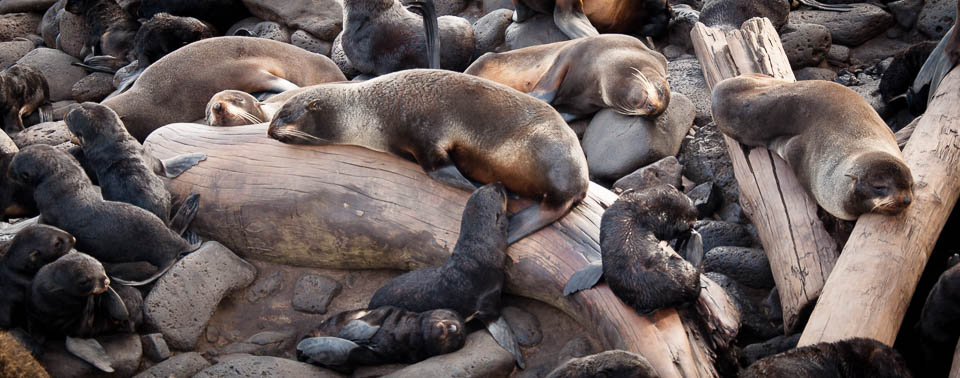
New Behaviors Observed in Northern Fur Seals
Thanks to the emergence of new technologies in tagging, scientists are able to gain an unprecedented level of insight into the movements of marine mammals in the wild. These data offer an important window into the daily habits of northern fur seals, and provide possible explanations for the population decline occurring in the central Bering Sea.

A pup suckles while others frolic around exhausted adult northern fur seals. The pups shown here on St. Paul Island fasted for an average of 7 days while their mothers foraged far from the rookery.
A new Consortium study led by Brian Battaile (University of British Columbia) used data loggers to identify several previously undocumented behaviors amongst northern fur seals, and to gain new insights into their activity at sea.
Using data loggers that were temporarily affixed to 82 female northern fur seals, the researchers gathered valuable data about how each animal behaved at sea, including its orientation in the water, the depth of its dives, and its rate of movement through the water. By analyzing the combined data, the researchers were able to describe how the animals moved through the water.
Shaking & Rolling

Brian Bataille observing northern fur seals on Bogoslof Island.
“We were interested in recording fur seal behaviors, and discovering how much time fur seals from a declining and an increasing population in Alaska spent grooming, travelling, sleeping and diving,” says Battaile. “Some of the shaking and grooming behaviors we saw had been described before, but the things that were really new, were two types of rolling behaviors and a prone position.”
The researchers identified the new rolling behaviors as a revolving 300-degree ‘w-spin’ and a 360-degree ‘sine spin’. To confirm these behaviors, the scientists observed tagged northern fur seals they are studying at the Vancouver Aquarium, and matched those same behaviors to the recorded wild data.

Swimming behaviors of female northern fur seals observed at the Vancouver Aquarium.
The data from the wild fur seals enabled the researchers to construct an at-sea activity budget, which describes how the seals typically spend their time at sea.
“The at-sea activity budget tells what percentage of the time they spent travelling, diving, shaking, or grooming,” says Battaile. “We were surprised to see that they spent as much as 30 percent of their time doing the two new rolling behaviors, primarily at the surface. We are not sure what the point of it is, but suspect it may allow the seals to search and scan an area while swimming at high speeds.”
Island Insights
The mystery deepened when the researchers compared data from animals in two distinct but nearby populations—St. Paul Island and Bogoslof Island. From an earlier study, the researchers knew that animals from the increasing Bogoslof population were travelling shorter distances to their feeding grounds than the animals from the declining St. Paul population. They wondered whether this may translate into different behaviors at sea—but this was not the case when they looked at the data.

Study sites in the eastern Bering Sea. Northern fur seals were tagged for this study on St. Paul Island and Bogoslof Island. Also shown are the 50, 100 and 200m depth contours.
“We were surprised to find that there weren’t any differences in the proportion of behaviors between the two populations,” says Battaile. “We expected to see more travelling-type behaviors in the St. Paul animals because they travel so much further. Similarly, we expected to see more resting-type behaviors and less diving time in the Bogoslof animals because we assumed they were getting into denser foraging areas and wouldn’t need to dive as much.”
Battaile says that their behaviors might be “hardwired” by other factors, such as the time of day. “An animal could be travelling around at the surface during daytime trying to find suitable foraging habitat,” he says, “but may be more likely to just dive at night when their prey are closer to the surface.”
Having a ‘daily diary’ for northern fur seals at sea will help energetics researchers construct an energy budget, which estimates how much energy the animals need to perform these basic activities. From this, researchers can calculate the amount of food needed to produce this energy, which could ultimately help determine why the St. Paul population is declining, as well as help make management decisions on fisheries quotas in the Bering Sea.
 PUBLICATION
PUBLICATION
|

|

|
||||||||||||
